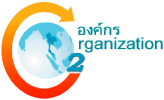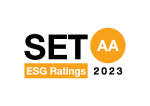Climate Strategy
Structure of climate action governance

| Organizational body | Role and responsibility concerning climate change |
|---|---|
| Board of Directors |
|
| Risk Management Committee |
|
| Corporate Governance and Sustainability Committee |
|
| Investment Committee |
|
| Audit Committee |
|
| Chief Executive Officer |
|
| Chief Power Business Development Officer |
|
| Executive Vice President - Related and New Business |
|
| Chief Asset Management Officer |
|
| Chief Financial Officer |
|
| Executive Vice President - Corporate Administration |
|
| Internal Audit Department |
|
Climate change is an integral part of RATCH’s Sustainability Strategy in environmental dimension, as it is a pressing issue in the energy and electricity sector. Stakeholders expect market players to reduce greenhouse gas emissions, so as to limit an increase in global temperature and mitigate climate impacts. RATCH thus prepared the Climate Change Strategy to achieve carbon neutrality in 2050. Approving the strategy, the Board of Directors demanded studies in feasible carbon emission approaches and methods for the formation of Decarbonization Roadmap and setting of achievable targets in alignment with Thailand’s target.
The Climate Change Strategy will also shape operational guidelines in support of SDG 12: Responsible Consumption & Production and SDG 13: Climate Action.

Climate Change Strategy
| Climate Change Strategy | Performance in 2024 | Supports to SDGs |
|---|---|---|
| Operational efficiency enhancement |
|
SDG 12: Ensure sustainable consumption and production patterns
SDG 13: Take urgent action to combat climate change and its impacts
|
| External collaboration |
|
|
| Production efficiency enhancement |
|
|
| Green and renewable business investment |
|
|
| Carbon offsetting and trading |
|
Assessment of climate-related risks and opportunities
RATCH requires a risk review every 3 years accordingly to the Recommendations of the Task Force on Climate-Related Financial Disclosures (TCFD). In 2023, RATCH reviewed the assessment of risks of 22 investment projects in Thailand, Australia, Indonesia and Vietnam under the TCFD framework. There was no change in physical risks, both acute and chronic risks, or transition risks driven by changes in related policy, legislation or requirements and technology. However, additional risk management measures were introduced. Details are summarized as follows:
Climate risks
| Physical Risks | ||
|---|---|---|
| Type of risk | Acute risks | Chronic risks |
| Possible events |
|
|
| Possible Impacts |
|
|
Analysis of physical risks
RATCH based the assessment of physical risks of operational controlled entities in Thailand, Australia, Vietnam and Indonesia on 2 scenarios, considering the level of impacts: Scenario RCP2.6 (lowest impact) when average global temperature could be 1.6 degree Celsius warmer in 2050 and Scenario RCP8.5 (highest impact) when average global temperature could be 4.3 degree Celsius warmer in 2050.
The analysis took into consideration significant impacts on the Company’s strategies in 6 aspects: 1) Finance 2) Health, safety and he environment 3) Partners and customers 4) Regulatory landscape 5) Reputation and image and 6) Target and achievements. The impacts may be witnessed in 3 periods: short term (within 2 years), medium term (3-5 years) and long term (6-10 years).
Summary of physical risk analysis results
| Physical risk factor: Drought | ||
|---|---|---|
| Impact forecast | Water shortage or insufficient volume of usable water for power generation, affecting the Company Group’s business activities and the main source of income. | |
| Impact period | Short and medium terms | |
| Assessment result | Australia’s drought timescale tends to lengthen the most under Scenario RCP2.6, 8% in 2030 and 8.5% in 2050 | |
| Response measures |
|
|
| Physical risk factor: Floods | ||
|---|---|---|
| Impact forecast | Damage to high-value assets and machinery, causing impacts on production and transmission system. | |
| Impact period | Short and medium terms | |
| Assessment result | Maximum number of days with heavy rainfall in Thailand, Vietnam and Indonesia tends to increase the most under Scenario RCP 8.5 in 2050. | |
| Response measures |
|
|
| Physical risk factor: Extreme weather | ||
|---|---|---|
| Impact forecast |
|
|
| Impact period | Long term | |
| Assessment result | Extreme weather conditions particularly on the wind speed in Thailand, Vietnam and Indonesia tends to increase the most under Scenario RCP8.5 in 2050. | |
| Response measures | The risk does not impose significant impacts on the Company, concerning damage to infrastructure, injury or damage to the transmission grid due to lightning. As such, response measures follow legal requirements and requirements specified in the EIA. | |
Analysis of transition risks
| Type of risk | Aspect | Impact characteristics |
|---|---|---|
| Marketing | Changes in consumer and customer behaviors | Customers demanding renewable energy credits to reduce their GHG inventories in Scope 2 emissions. |
| Regulatory landscape | Change in legislation, regulations and policies | Enforcement of legislation relating to carbon emission reduction like the carbon trading scheme on the right to emit greenhouse gases; and the Power Development Plan for renewable energy that demands additional investment from energy companies for climate impact mitigation. |
| Technology | Change in technological innovation | Emergence of new products and services like new forms of renewable energy or energy management systems. |
| Reputation and image | Change in stakeholder mindset | Stakeholders particularly financial institutions and investors pay more attention to corporate actions on climate change: Some have pulled out investment in or reduced funding to fossil fuel power projects. |
RATCH applies 3 scenarios - State Policy Scenario, Sustainable Development Scenario (SDS) and Net Zero Emission Scenario (NZE) - to analyse risks and significant impacts to the enterprise. The impacts concern these 6 aspects: 1) finance, 2) health, safety, environment 3) partners and customers 4) legal and regulatory requirements 5) reputation and image and 6) target achievements. The impacts may be witnessed in the short term (0-2 years), medium term (3-5 years) and long term (6-10 years).
Analysis results
The possible imposition of carbon tax to control or limit greenhouse gas emissions poses a risk on the operating expenses or production cost of power generation entities. The cost will rise in relation to the volume of electric power generated from fossil fuels and emissions. The risk may be eminent in the next 3-5 years.
Response measures
- Devise the Climate Change Strategy and the Decarbonization Roadmap, with the goal to achieve carbon neutrality in 2050.
- Target to raise the ratio of renewable energy capacity to 30% in 2030 and 40% in 2035.
- Invest in or acquire new renewable energy assets or fossil fuel power plants with installed carbon storage technology and avoid or abolish investment in coal-fired power plants.
- Set investment target for low-carbon businesses, innovation, future energy like hydrogen, energy efficiency management, and electric vehicles and related businesses.
- Set carbon offsetting target from forest reforestation, rehabilitation and conservation; and increase internal use of renewable energy.
RATCH reviewed risks in 2024 and assessed the risks and likelihood as guided by the Task Force on Climate-related Financial Disclosures (TCFD) framework. In focus were acute, chronic and transition risks that may arise from changes in policies, legal clauses and relevant technology. The assessment found no change from the previous year.
Analysis of climate-related opportunities
Transition risks in the marketing, technology and regulatory aspects can create negative impacts on the Company’s operations. Nevertheless, they may create business opportunities. RATCH reviewed its investment plan and set a target to increase investment in low-carbon businesses and non-power businesses. Target fields involve green hydrogen, businesses in the electric vehicle value chain, solar and wind power projects, renewable energy storage system, and businesses related to the installation, production and maintenance of solar farms.
Additionally, RATCH had strengthened the capability of relevant personnel relating to TCFD recommendations, the assessment of climate-related risks and opportunities, the assessment and calculation of organization carbon footprints in Scope 1-3, internal carbon pricing, IFRS S2 Climate-related Disclosures, and updates on the situation and impacts of climate change.
RATCH has integrated the management of climate-related risks and opportunities into the enterprise risk management and under the responsibility of the Corporate Planning and Systems Development Department, identified performance indicators. All functions will work together through the Risk Management Working Committee, the ESG Working Committee and the Performance Evaluation Committee. The operational results are reported to the Management, the Risk Management Committee, the Investment Committee, the Corporate Governance and Sustainability Committee and the Board of Investors, respectively, for their consideration and acknowledgement. Meanwhile, the Internal Audit Department is tasked to monitor the efficiency and sufficiency of the risk management system and report to the Audit Committee.
GHG reduction targets
| Strategy | 2035 targets | 2030 targets | Performance in 2024 |
|---|---|---|---|
| 1. Mix of fuels for power generation |
|
|
|
| 2. GHG emission reduction |
|
|
|
| 3. Increase in GHG sequestration |
|
|
|






